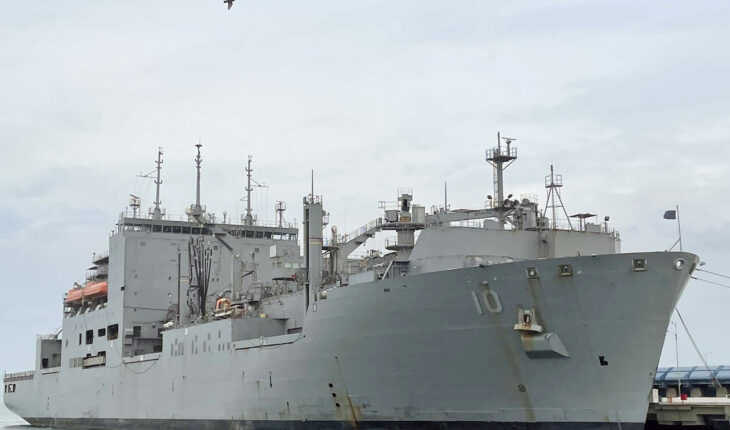Abhijit Singh delves into India-US comprehensive partnership in the Indian Ocean littorals, The docking of the USNS Charles Drew, a United States Navy dry cargo ship, for repairs at an Indian facility in Chennai last week, marks an important first in the India-U.S. military relationship. Although bilateral strategic ties have advanced considerably over the past decade, reciprocal repair of military vessels was still a milestone that had not been crossed. With the arrival of Charles Drew at the Larsen and Toubro (L&T) facility at the Kattupalli dockyard, India and the U.S. seem to have moved past a self-imposed restriction.
Signs of a broader template
As some see it, a renewed sense of optimism now drives India-U.S. relations. During the bilateral 2+2 dialogue held in April this year, the two countries agreed to explore the possibilities of using Indian shipyards for the repair and maintenance of ships of the U.S. Military Sealift Command (MSC). In the weeks following that meeting, the MSC carried out an exhaustive audit of Indian yards, and cleared the facility at Kattupalli for the repair of U.S. military vessels.
The docking of a U.S. military vessel at an Indian facility has both functional and geopolitical implications. Functionally, it signals a more efficient leveraging of the Logistics Exchange Memorandum of Agreement (LEMOA) — the military logistics agreement India signed with the U.S. in 2017. Thus far, India-U.S. cooperation under the pact had largely been confined to the exchange of fuel and stores during joint exercises and relief operations. With the arrival of a U.S. military vessel at an Indian dockyard, the template of logistics cooperation seems to have broadened. There is a good possibility now that India would seek reciprocal access to repair facilities at U.S. bases in Asia and beyond.
Many in India, meanwhile, are seeing the U.S. ship’s docking as a global endorsement of Indian shipbuilding and ship-repair capabilities. In recent years, New Delhi has sought to showcase its private shipyards, in particular the L&T, which has developed significant ship design and construction capability at its yards in Hazira (Gujarat) and Kattupalli. At a time when the Indian Navy has taken delivery of the INS Vikrant, the country’s first indigenously constructed aircraft carrier, the spirits of Indian shipbuilders are already riding high. As Indian observers see it, the presence of the USNS Charles Drew in an Indian dockyard is a boost for ‘Atmanirbhar Bharat’ and ‘Make-in-India’.
The political signal
Politically, too, the development is noteworthy, as it signals a consolidation of the India-U.S. partnership, and the Quadrilateral (India, Japan, Australia and the United States) Security Dialogue. Despite its intention to strengthen logistics exchanges among Quad members, New Delhi has desisted from offering foreign warships access to Indian facilities. Notwithstanding the odd refuelling of foreign warships and aircraft in Indian facilities, India’s military establishment has been wary of any moves that would create the impression of an anti-China alliance. Yet, Indian decision makers evidently are willing to be more ambitious with the India-U.S. strategic relationship. New Delhi’s decision to open up repair facilities for the U.S. military suggests greater Indian readiness to accommodate the maritime interests of India’s Quad partners.
For Washington, the strategic implications of the docking in India are no less tangible. This is an incremental step forward in the U.S. moving to bolster its military presence in the Eastern Indian Ocean. Recent assessments of the evolving security picture in the Indian Ocean point to the possibility of China’s military expansion in the Asian littorals, holding at risk U.S. and European assets. Reportedly, the North Atlantic Treaty Organization (NATO) has been readying to play a more active security role in the region. New Delhi’ s offer of repair services for U.S. military vessels could kickstart a process that would culminate in India opening up its naval bases for friendly foreign warships. At a time when New Delhi has shied away from backing the U.S. position in the Russia-Ukraine war, greater India-U.S. synergy in the Indian Ocean littorals could galvanise the supporters of closer bilateral ties. It would revive talk about the bilateral as a defining partnership in the Indian Ocean, and of India’s potential to counter China in the Indian Ocean. Coming on the heels of the delivery of the first two U.S. manufactured MH-60R (Multi Role Helicopters) to India (with a third craft due to arrive later this month) the visit of the USNS Charles Drew has given Indian and U.S. observers much to be optimistic about.
CMF cooperation
Meanwhile, the Indian Navy has formally commenced its cooperation with the Bahrain-based multilateral partnership, Combined Maritime Forces (CMF), as an ‘associate member’. This comes months after India had announced its intention to join the grouping in furtherance of its regional security goals. India’s political and military leadership is seeing this as a demonstration of Indian commitment towards the collective responsibility of ensuring security in the shared commons.
Indian analysts, however, ought not to overread developments, as extrapolating from perceived trends can often be misleading. The reality is that the India-U.S. relationship is still some way from crossing a critical threshold. For all the hype in the media surrounding India’s membership of the CMF, the modalities of the engagement are still being worked out. The Indian Navy, it seems, has stopped short of formally joining the group, of which the Pakistan Navy is a key member. According to the CMF website, “associate members provide the assistance that they can offer, if they have the time and capacity to do so, whilst undertaking national tasking”. This is not unlike India’s earlier model of cooperation, whereby the Indian Navy worked alongside CMF and other security forces in the Western Indian Ocean on a need-to basis — all while operating independently, and under the broader banner of the United Nations. Despite increased engagement with the U.S. Navy, India’s liaison officer at the U.S. Navy component (NAVCENT, or the U.S. Naval Forces Central Command) in the U.S. Central Command (CENTCOM) is still the military attaché at the Indian Embassy in Bahrain.
Abhijit Singh is a retired Indian naval officer and Senior Fellow at the Observer Research Foundation in New Delhi. Views are personal.






